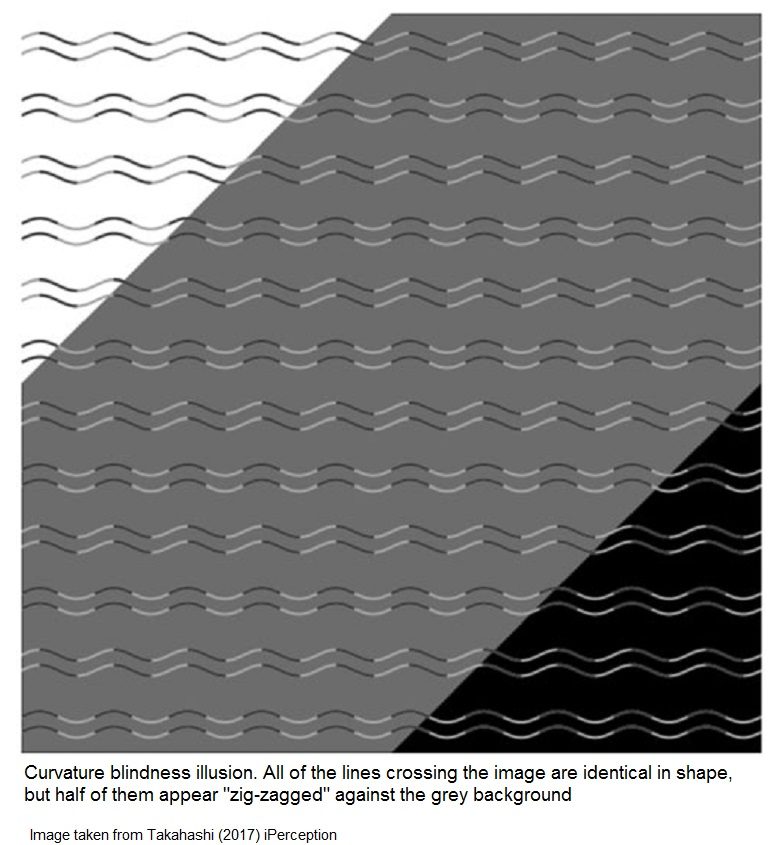Here's an example of the illusion:
A series of wavy horizontal lines are shown. All of the lines have exactly the same shape - a sine curve. However, half of the lines appear to have a much more triangular, "zig-zag" shape, when they are superimposed on a grey background. This "zig-zag" appearance is an illusion. (I checked - it really is.)
Takahashi notes the unusual strength of this effect:
As the effect magnitudes are quite strong, unless one carefully stares at the region that looks like a corner, it is hard to find that all lines are physically wavy. Despite the simplicity and effect magnitudes, to the best of our knowledge, no one has reported about this phenomenon.So what's going on here? Takahashi proposes that the brain's visual system may default to seeing corners when there is ambiguity over whether a line is a smooth curve or not:
The underlying mechanisms for the gentle curve perception and those of obtuse corner perception are competing with each other in an imbalanced way and the percepts of corner might be dominant in the visual systemThe "zig-zag" lines in the illusion are the ones in which the color of the wavy line changes from dark grey to light grey at the 'corners' i.e. the peaks and troughs of the curve. It is only seen against a medium grey background however, suggesting that what matters is that the color of the wavy lines shifts from being lighter than the background, to being darker than it.
Takahashi notes that the illusion involves a sense of depth: the "zig-zag" lines look a bit like a surface, or wall, going into and out of the page, and the changing color of the wavy line suggests shadows. However, further experiments revealed that depth perception is not the driving force behind the effect.




Reader Comments
But that is exactly what I notice at the zig zags, the lines look to be going in/out.. How did they eliminate this? Also, zoomed in the zig lines look to have a poor resolution of the curvature compared to the white or black background. Seems like either the contrast kills it or the way they made the image.
I, too, see 'depth' in both 'types' of lines once they hit the grey area. Where do they 'hit' the grey area?
I see it as being from left (white) side of the grey zone. Do you too?
Is that because:
- We are programmed by reading to look left to right;
- We are programmed to first notice light areas before dark areas (the right side is black)
- Something else?
Finally, I bet that if the white and black were exchanged the effect would not be nearly as dramatic. Why? Because the picture gives the illusion of a light source from the left. (I guess anyone could test it by putting it through their 'paint' or equivalent and 'inverting' some of the colors.)
The most obvious part of the cause is that the right side of the zig zag looking lines look like they're shadowed from a light to the left where the white is.
R.C.
Your brain falls behind when deciphering the contrast difference for three values converging instead of just two. Since the values are converging on the arches instead of between the arches it overwhelms your contrast discrimination. It is this designed lack of contrast sensitivity that bleeds out the curve of the line.
This frame is like the illusions they painted on boats in WWII. Just a different contrast pattern.
This is NOT a new illusion/phenomena. Just a new application for an already discovered one.
It is the differences in contrast and your brain trying to take visual processing shortcuts (that work under most circumstances). Simply put.